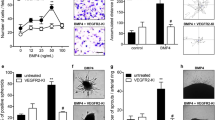Abstract
A paradox of Flt-1, a tyrosine kinase receptor for vascular endothelial growth factor (VEGF), is that the ligand cannot activate the receptor to stimulate growth of cells that exogenously overexpress the receptor. In order to find Flt-1 kinase-dependent biological systems, we obtained for the first time activated forms of the Flt-1 kinase in a ligand-independent manner. Replacement of the ABL sequences in the human leukemia oncoprotein BCR–ABL with the cytoplasmic domain of Flt-1 (BCR–FLT) followed by a retroviral random mutagenesis scheme gave constitutively active artificial chimera BCR–FLTm with mutations within the Flt-1 sequence. Like BCR–ABL it could, but not the original BCR–FLT, transform Rat1 fibroblasts, abrogate cytokine dependence in Ba/F3 cells, and induce neurite-like structures in neuronal PC12 cells. Interestingly, Rat1 cells transformed by BCR–FLTm formed tube-like structures in basement membrane matrix. BCR–FLTm retroviruses may be a very useful tool to investigate an as yet uncovered functions of the Flt-1 kinase.
Similar content being viewed by others
Author information
Authors and Affiliations
Rights and permissions
About this article
Cite this article
Maru, Y., Yamaguchi, S. & Shibuya, M. Flt-1, a receptor for vascular endothelial growth factor, has transforming and morphogenic potentials. Oncogene 16, 2585–2595 (1998). https://doi.org/10.1038/sj.onc.1201786
Received:
Revised:
Accepted:
Published:
Issue Date:
DOI: https://doi.org/10.1038/sj.onc.1201786
- Springer Nature Limited
Keywords
This article is cited by
-
Molecular basis of VEGFR1 autoinhibition at the plasma membrane
Nature Communications (2024)
-
VEGF targets the tumour cell
Nature Reviews Cancer (2013)
-
FLT1 and its ligands VEGFB and PlGF: drug targets for anti-angiogenic therapy?
Nature Reviews Cancer (2008)
-
The biology of VEGF and its receptors
Nature Medicine (2003)
-
Molecular Biology of Chronic Myeloid Leukemia
International Journal of Hematology (2001)




